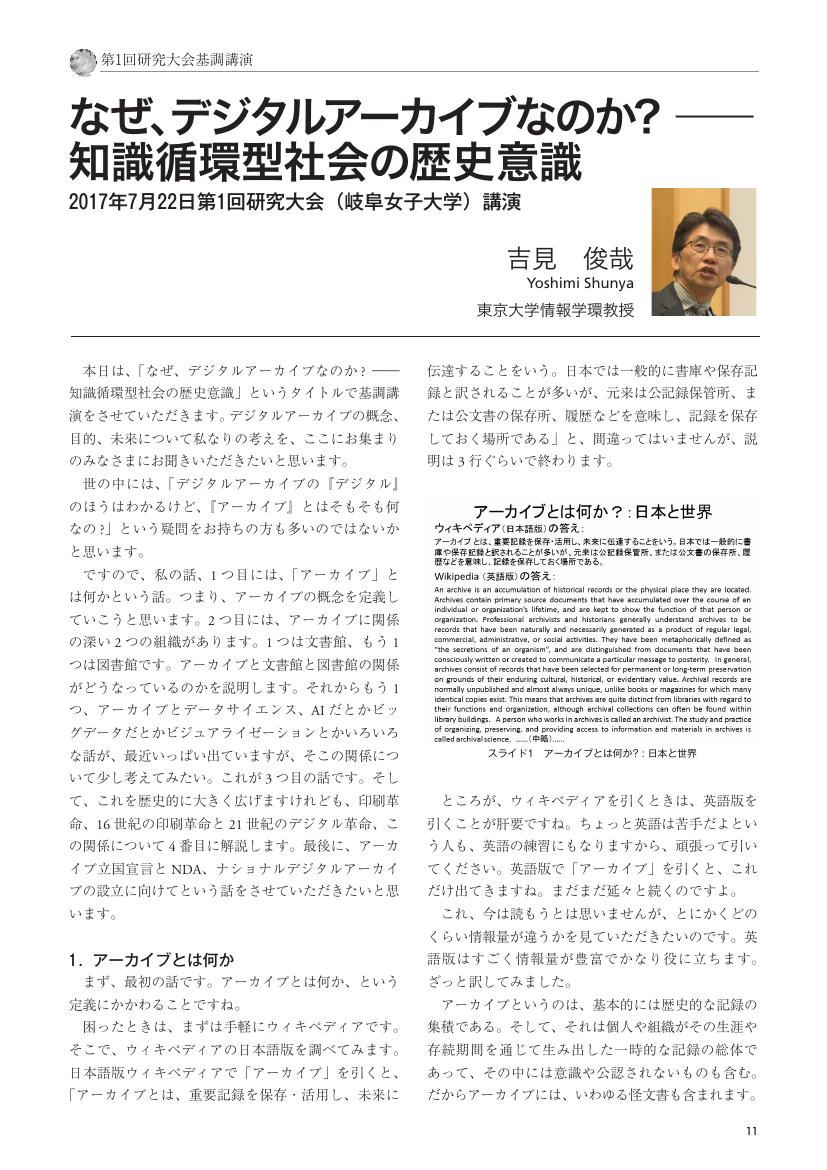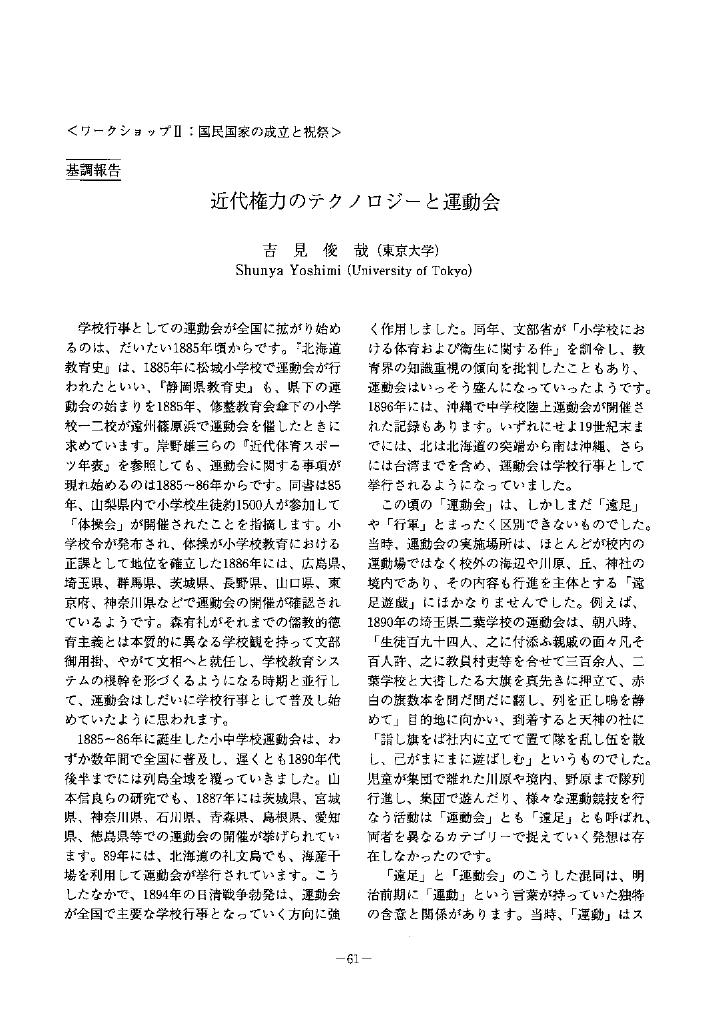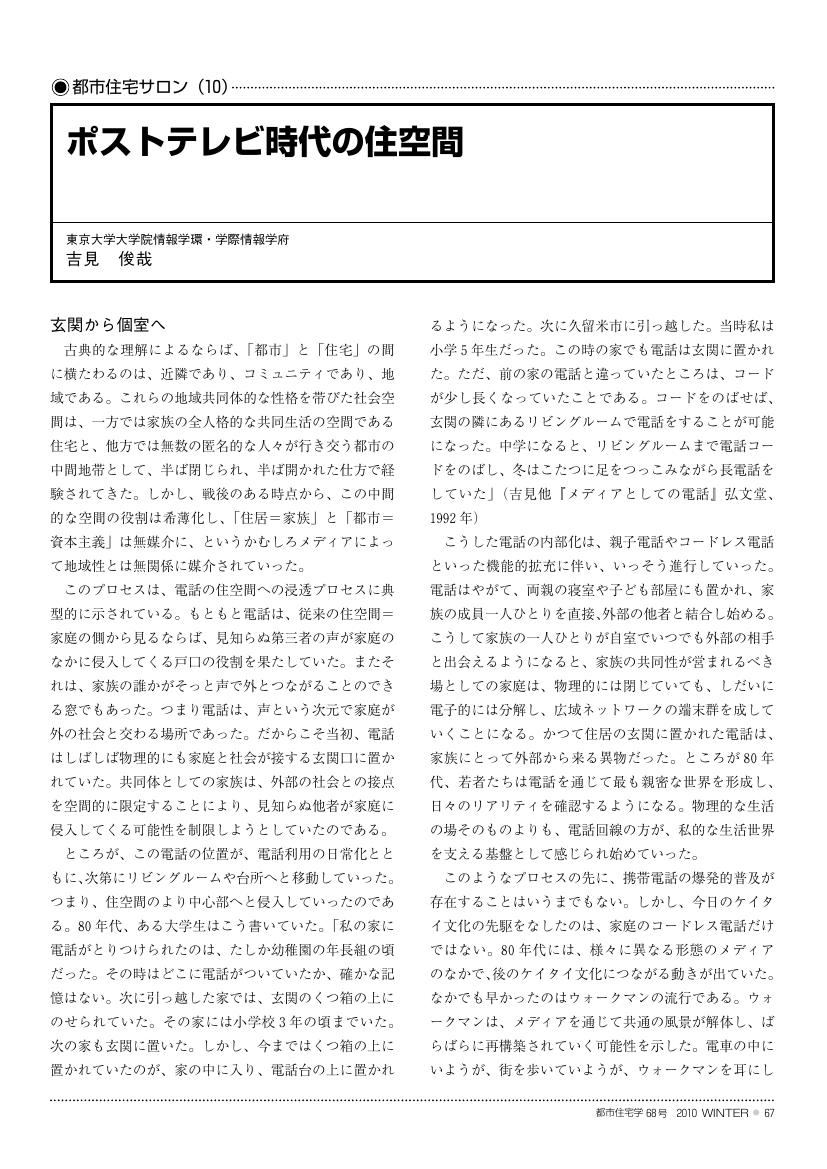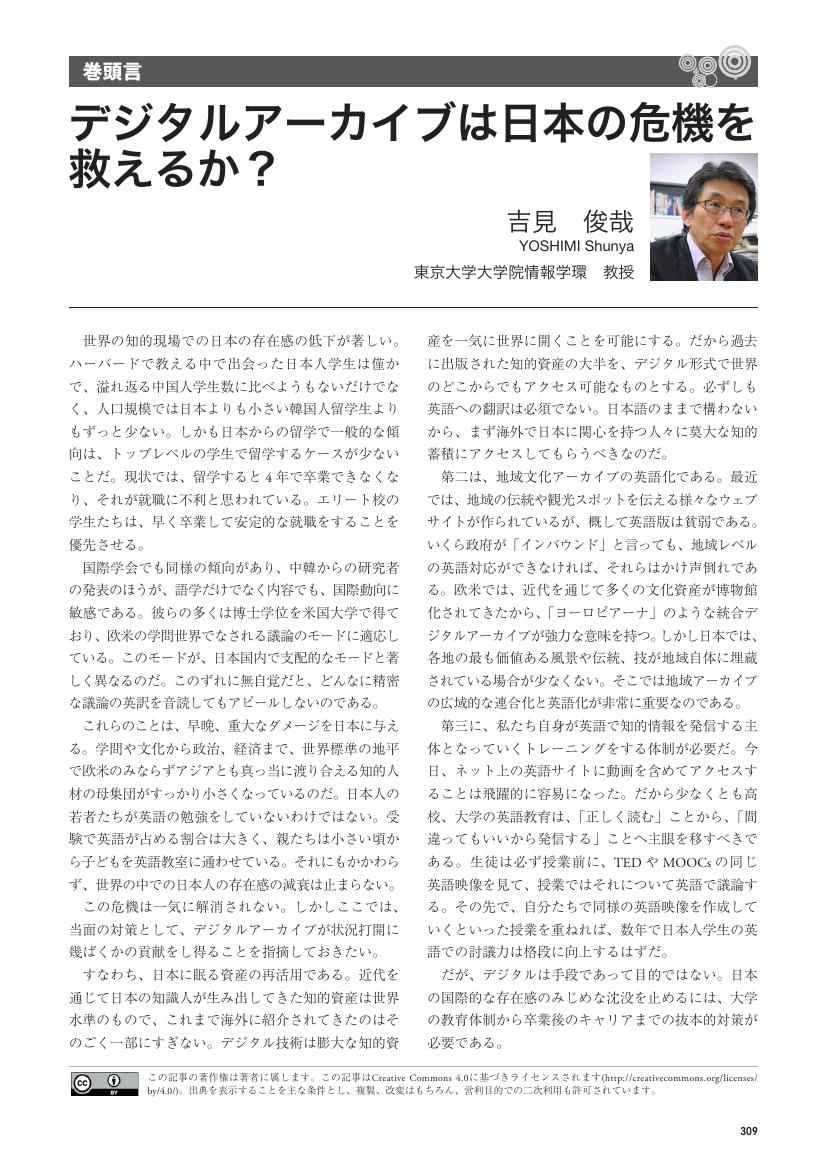13 0 0 0 OA コミュニケーションとしての大衆文化(<特集>マス・コミュニケーション研究の系譜)
- 著者
- 吉見 俊哉
- 出版者
- 日本マス・コミュニケーション学会
- 雑誌
- 新聞学評論 (ISSN:04886550)
- 巻号頁・発行日
- no.39, pp.78-105, 1990-04-30
11 0 0 0 OA デジタル時代における知識循環型社会の価値創造基盤
- 著者
- 吉見 俊哉
- 出版者
- 国立研究開発法人 科学技術振興機構
- 雑誌
- 情報管理 (ISSN:00217298)
- 巻号頁・発行日
- vol.56, no.8, pp.491-497, 2013-11-01 (Released:2013-11-01)
- 被引用文献数
- 1 1
5世紀前のグーテンベルク革命に比べられる今日のデジタル革命は,社会の記憶構造を大きく変化させる可能性がある。過去が消えなくなり,無限に集積されていく情報資源となりつつある。この情報資源を保存し,再利用可能にしていくには,以下の4点の基盤整備が重要である。第1は,新たな知識コンテンツの公共的再利用に必要な法システムの整備である。とりわけ著作権者や所有権者が不明な知的資源を公的に再利用できるようにすることが喫緊の課題である。第2に,新しい知識循環型社会のプロデューサーとなっていくことができる専門職人材の雇用を生み出す必要がある。第3は,日本やアジアの文化を世界に向けて発信・再活用していく基盤となるナショナルアーカイブの構築である。第4に,新しい知識循環型社会では,ローカルなレベルで「わが町・わが村・わが地域」の記憶を呼び戻していく開かれた仕組みが整備されていかなければならない。
8 0 0 0 OA 長尾真前会長追悼座談会:長尾先生と私たち
- 著者
- 岡本 真 黒橋 禎夫 土佐 尚子 柳 与志夫 吉見 俊哉
- 出版者
- デジタルアーカイブ学会
- 雑誌
- デジタルアーカイブ学会誌 (ISSN:24329762)
- 巻号頁・発行日
- vol.6, no.s1, pp.s8-s20, 2022-06-01 (Released:2022-05-28)
7 0 0 0 OA マスの知 メディアの知 何が問われてきたのだろうか
- 著者
- 吉見 俊哉
- 出版者
- 日本メディア学会
- 雑誌
- マス・コミュニケーション研究 (ISSN:13411306)
- 巻号頁・発行日
- vol.97, pp.3-16, 2020-07-31 (Released:2020-09-26)
- 参考文献数
- 16
This article focuses on the historical transformation of the concept of ‘mass’in the contemporary social sciences. First, the ‘masses’ is the collective object conceptualized in a specific historical context that had emerged in the early 20th century and disappeared by the end of the century. Before the emergence of this concept, the elite and intellectuals were struck with fear of the expanding images of crowds of poor laborers. After the W.W.I, the uncontrollable image of the crowd has changed to the image of the ‘masses’ who could be mobilized as soldiers and consumers. Especially after W.W.II, the concepts of ‘mass society’ and ‘mass communication’ were often discussed. The sociological theory of ‘mass society’ became a major discourse in sociology and the ‘mass communication’ theory became the hegemonic discourse in the field of media studies. The author also discussed the subtle difference of the concept of ‘mass’ in the different academic fields such as sociology, communication studies, and cultural studies. Finally, this article discusses the transformation of the concept of ‘mass’ in digital society from the 21st century onward. Today, ‘mass’ is more discussed with the expansion of the ‘mass data’ than the ‘mass society’. The author analyzes the structural transformation of our society with digital technology in this conceptual change. Today, we are facing the expansion of ‘mass data’ that seems to be uncontrollable for ordinary people. Although the society of ‘mass data’ is quite different from the society of ‘mass communication’, it is still a subject in the field of media studies. So, the major focus of the next generation of media studies should be the critical analysis of the relationship between our society and ‘mass data’ that has been appropriated with highly developed algorithms in digital society.
6 0 0 0 OA なぜ、デジタルアーカイブなのか? ―知識循環型社会の歴史意識
- 著者
- 吉見 俊哉
- 出版者
- デジタルアーカイブ学会
- 雑誌
- デジタルアーカイブ学会誌 (ISSN:24329762)
- 巻号頁・発行日
- vol.1, no.1, pp.11-20, 2017-09-09 (Released:2017-11-16)
6 0 0 0 OA 長尾真会長の文化勲章受章を祝して
- 著者
- 吉見 俊哉
- 出版者
- デジタルアーカイブ学会
- 雑誌
- デジタルアーカイブ学会誌 (ISSN:24329762)
- 巻号頁・発行日
- vol.3, no.1, pp.2, 2019-01-07 (Released:2019-02-18)
5 0 0 0 OA アメリカの終わりと日本の末路 21世紀はどんな時代か
- 著者
- 吉見 俊哉
- 出版者
- カルチュラル・スタディーズ学会
- 雑誌
- 年報カルチュラル・スタディーズ (ISSN:21879222)
- 巻号頁・発行日
- vol.5, pp.5, 2017 (Released:2019-10-09)
- 著者
- 吉見 俊哉
- 出版者
- 日本マス・コミュニケーション学会
- 雑誌
- マス・コミュニケーション研究 (ISSN:13411306)
- 巻号頁・発行日
- vol.86, pp.19-37, 2015-01-31 (Released:2017-10-06)
- 参考文献数
- 42
In postwar Japan, the Olympic Games were organized as "postwar" events in the strict sense of the term-specifically, the Olympic Games not only symbolized the history of Japan's postwar recovery and economic growth, but also the athletic facilities that provided stages for many national dramas were postwar products created by transforming facilities used for military purposes during the war. Many of the national dramas that unfolded on these stages were also products created by shifting the focus of dramaturgy from military heroism to athletic heroism. The term "postwar period" as used here refers to the transition from militarism (war) to peace. In this paper, we first verify that the major facilities for the 1964 Tokyo Olympic Games were constructed on former Japanese military facility sites. Next, we confirm that throughout Japan, after the war many athletic facilities were constructed in places where military facilities were located during the war. Then, we reveal that in the process of returning Washington Heights in Yoyogi to Japan in order to construct facilities for the Olympics, there was a gap between the intentions of the United States and the Japanese government, which was actually seeking the return of the U.S. base in Asaka. In addition, we also confirm that the Oriental Witches and Kokichi Tsuburaya, who played leading roles in the national dramas of the Olympics, were both closely tied to the process through which a poor nation turned itself into an industrialized country-the Oriental Witches as former female workers of cotton mills, and Tsuburaya as a member of the Self-defense Forces from the Tohoku region. Thus, this paper aims to throw light on the continuous elements from the war period of the 1964 Olympic Games.
4 0 0 0 OA 総論:映像で書かれる歴史とデジタルアーカイブ
- 著者
- 吉見 俊哉
- 出版者
- デジタルアーカイブ学会
- 雑誌
- デジタルアーカイブ学会誌 (ISSN:24329762)
- 巻号頁・発行日
- vol.3, no.4, pp.368-369, 2019-12-16 (Released:2019-12-16)
3 0 0 0 OA 文系の知とは何か?—長く広い歴史のなかで未来を見通す—
- 著者
- 吉見 俊哉
- 出版者
- 香川大学大学教育基盤センター紀要編集委員会
- 雑誌
- 香川大学教育研究 = Journal of research in higher education, Kagawa University (ISSN:13490001)
- 巻号頁・発行日
- vol.15, pp.29-45, 2018-03-01
3 0 0 0 OA ワークショップⅡ:国民国家の成立と祝祭 基調報告 近代権力のテクノロジーと運動会
- 著者
- 吉見 俊哉
- 出版者
- 体育史学会
- 雑誌
- 体育史研究 (ISSN:09144730)
- 巻号頁・発行日
- vol.15, pp.61-70, 1998 (Released:2022-10-08)
3 0 0 0 OA ポストテレビ時代の住空間
- 著者
- 吉見 俊哉
- 出版者
- 公益社団法人 都市住宅学会
- 雑誌
- 都市住宅学 (ISSN:13418157)
- 巻号頁・発行日
- vol.2010, no.68, pp.67-70, 2010 (Released:2017-06-29)
3 0 0 0 OA 長尾真先生をしのぶ
- 著者
- 吉見 俊哉
- 出版者
- デジタルアーカイブ学会
- 雑誌
- デジタルアーカイブ学会誌 (ISSN:24329762)
- 巻号頁・発行日
- vol.6, no.s1, pp.s7, 2022-06-01 (Released:2022-05-28)
3 0 0 0 OA 長尾真先生のご逝去を悼む
- 著者
- 吉見 俊哉
- 出版者
- デジタルアーカイブ学会
- 雑誌
- デジタルアーカイブ学会誌 (ISSN:24329762)
- 巻号頁・発行日
- vol.5, no.3, pp.137, 2021-07-01 (Released:2021-08-30)
3 0 0 0 OA デジタルアーカイブは日本の危機を救えるか?
- 著者
- 吉見 俊哉
- 出版者
- デジタルアーカイブ学会
- 雑誌
- デジタルアーカイブ学会誌 (ISSN:24329762)
- 巻号頁・発行日
- vol.2, no.4, pp.309, 2018-10-01 (Released:2018-11-20)
3 0 0 0 OA 知識循環型社会とアーカイブ
- 著者
- 吉見 俊哉
- 出版者
- 日本社会学会
- 雑誌
- 社会学評論 (ISSN:00215414)
- 巻号頁・発行日
- vol.65, no.4, pp.557-573, 2015 (Released:2016-03-31)
- 参考文献数
- 47
デジタル革命は社会的記憶の構造を持続的に変化させる. デジタル技術は同じ情報が大量複製されていっせいに伝播・流通し, 大量消費されていくというマス・コミュニケーションの回路に介入し, <生産→流通→消費> の空間軸の組織化を, <蓄積→検索→再利用> の時間軸の組織化へと転換させる. もはや <過去> は消えなくなり, 無限に集積されていく情報資源となる. ここで必要なのは, 文化の創造的「リサイクル」である. 古い記録映像は, 音や色を与えられて新しい教育の貴重な「資料」となり, 古い脚本のデータは新しいドラマ作品を創造していく基盤となる. この転換には, まず散在するさまざまな形態のメディア資産の財産目録を作成し, 原資料を安定的な保存環境に集めていく取り組みを進める必要がある. また, アーカイブ化されたデジタルデータについて, 共通フォーマットにより標準化を進め, 公開化と横断的な統合化を進めることも重要である. さらに, デジタルアーカイブ運用のための人材育成, 教育カリキュラムにアーキビスト育成を取り込んでいくことも必要となる. デジタル時代のアーカイブでは, 保存の対象はけっして政府・行政機関の公文書に限定されない. アーカイブ化される資料や情報には, 地域の人びとによって撮影されたり語られたりした情報が大量に含まれるし, マスメディアやインターネットの情報がともに保存されていく. それらの情報全体が, 国境を越えて結びついていくのである.
2 0 0 0 OA 2 電話コミュニケーションの再検討
- 著者
- 吉見 俊哉 水越 伸 若林 幹夫 三上 俊治
- 出版者
- 日本マス・コミュニケーション学会
- 雑誌
- 新聞学評論 (ISSN:04886550)
- 巻号頁・発行日
- vol.40, pp.325-326, 1991-04-30 (Released:2017-10-06)
- 著者
- 吉見 俊哉
- 出版者
- 教育思想史学会
- 雑誌
- 近代教育フォーラム (ISSN:09196560)
- 巻号頁・発行日
- vol.22, pp.121-133, 2013-09-14 (Released:2017-08-10)
本論文は、シンポジウム当日の報告に基づいて、今日における「大学の危機」をめぐる議論を踏まえつつ、思想史的な観点からポスト国民国家時代の知的空間として「大学」概念そのものを再定義することの必要性を強調し、メディアとしての大学という新たな視角を切り開くことを試みる。
2 0 0 0 OA デジタルアーカイブ憲章とは何か
- 著者
- 吉見 俊哉
- 出版者
- デジタルアーカイブ学会
- 雑誌
- デジタルアーカイブ学会誌 (ISSN:24329762)
- 巻号頁・発行日
- vol.7, no.3, pp.117-118, 2023-08-01 (Released:2023-10-11)
- 著者
- 吉見 俊哉
- 出版者
- 日本コミュニケーション学会
- 雑誌
- ヒューマン・コミュニケーション研究 (ISSN:09137041)
- 巻号頁・発行日
- vol.38, pp.5-17, 2010-03-31 (Released:2017-11-30)







